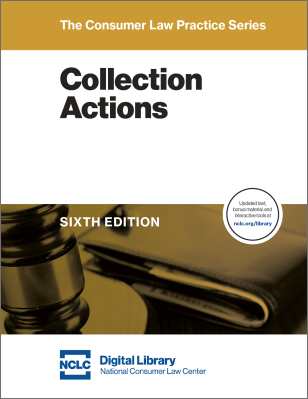This article describes best practices when taxpayers are unable to repay their IRS tax obligations. Consequences of not paying can be severe. Outstanding federal taxes may be collected for ten years, and the IRS has far-reaching authority to collect taxes—it can place a lien on property and levy property including bank accounts, wages, Social Security, and even pension payments. (See IRS Powers to Force Payment, below.) But as set out in this article, taxpayers have important options for dealing with tax debt to avoid the worst consequences and even reduce the amount owed.
This article is adapted from a chapter written by this author in NCLC’s Surviving Debt. Surviving Debt as a digital book is free to the public, and inexpensive print versions can be ordered here. Surviving Debt is an accessible guide providing advice on significant areas of consumer debt—medical debt, student loans, debt collection, credit reporting, collection lawsuits, mortgages, property taxes, rent, utilities, and much more.
File the Tax Return on Time Even If the Tax Payment Is Unaffordable
One of the worst things an individual can do if they cannot afford to pay their taxes is to not file a tax return. Individuals must file an income tax return if they are a U.S. citizen or resident alien, and their taxable income exceeds certain amounts that are adjusted annually for inflation. For the tax year 2024 (taxes due April 15, 2025) these amounts are:
- A single with taxable income exceeding $14,600.
- A head of a household with taxable income exceeding $21,900.
- Married filing as joint filers with taxable income exceeding $29,200.
- Self-employed and earning over $400.
April 15 is the typical deadline for most people to file their income tax returns and pay any taxes owed. Extensions for filing can easily be arranged until October 15, but this does not extend the time to pay.
If a person fails to file either an extension or a tax return by April 15, and the person would owe taxes on that return, the IRS will prepare a proposed tax return—called a “substitute for return”—which shows how much the IRS thinks the taxpayer owes. Generally, this amount is larger than what is owed. Taxpayers can dispute that determination by responding to the letter or filing a late return.
For late filings, the IRS assesses a late-filing penalty—5% of the taxes owed for each month or part of a month that the return is late, with a maximum penalty of up to 25% of the taxes owed. If a return is over 60 days late, the minimum penalty is the smaller of $450 or 100% of the tax owed.
In addition to the late-filing penalty, there is a late-payment penalty. For late payment, the IRS will assess a late-payment penalty, that is only a fraction of the larger penalty for not filing a return—it starts at only one half of 1% of the tax owed for each month late, up to a maximum of 25% of the taxes owed. There is also an assessment of interest on the unpaid tax and penalty.
While the IRS upon request will automatically provide a 6-month extension to file, this is only an extension of time to file. It does not provide more time to pay the taxes owed, and the taxpayer will be charged both interest and a late-payment penalty during the time of the extension if taxes owed are not paid in full by April 15.
A cardinal rule is to timely file a return or an extension even if the tax payment is unaffordable. Below, this article will discuss best practices for dealing with overdue tax payments.
Don’t Put Taxes on a Credit Card
If tax payments are unaffordable, do not put the taxes on a credit card which the taxpayer also will have trouble repaying. The IRS gives taxpayers a better deal than putting the tax payment on a credit card. Interest rates and penalties are lower, repayment options are better, and the IRS may even reduce the tax obligation.
Three IRS Options for Adjusting the Payment Obligation
When tax debt is unaffordable, the IRS offers three repayment options:
- Enter into a monthly payment plan (installment agreement);
- Negotiate for a smaller tax bill by seeking an “offer-in-compromise”; or
- Request hardship relief, called “currently not collectible” status.
All three options require IRS approval, although the IRS allows almost every taxpayer that owes less than $50,000 to enter into an installment agreement through a streamlined process available on their website. If the IRS does not grant approval for any one of the three options, the taxpayer has the right to seek an appeal or ask for a review of the case. These actions often require submission of IRS forms, which are available at www.irs.gov.
Option #1: An Installment Agreement
The IRS allows for overdue tax obligations to be paid in monthly installments. If less than $50,000 is owed, payments can be spread out over 72 months, or if between $50,001 and $100,000, 84 months.
If all required tax returns have been filed, a taxpayer can apply for a Direct Debit Installment Agreement (DDIA) (automatic monthly payments from a checking account). The IRS imposes a “set-up fee” for these automatic withdrawals of $107 for phone, mail, or in person applications; $22 for applications through the IRS website at www.irs.gov/payments; and $0 for low-income taxpayers.
Monthly payment plans also can be set up for payments that do not occur automatically:
- Directly from a checking or savings account (Direct Pay);
- Electronically online or by phone using Electronic Federal Tax Payment System (EFTPS.gov) (enrollment required); or
- By check, money order, or debit/credit card (fees apply when paying by card).
For these non-automatic payments, the IRS imposes a “user fee” of $178 to set up a monthly payment plan by phone, mail, or in-person; $107 if set up through the IRS website; and $43 for low-income taxpayers, which is eligible for reimbursement. There is no fee for a short-term payment plan which lasts 180 days or less.
In determining the amount of the monthly payment, the IRS will consider the taxpayer’s ability to pay, and a taxpayer may be eligible for a partial payment plan if unable to pay the entire balance.
For more details about monthly payment plans, visit www.irs.gov/payments or call the IRS at the phone number listed on a tax bill or notice. Be sure to ask for written confirmation of the installment plan negotiated.
Interest will continue to accrue until the entire balance is paid in full, currently at 8% per year, compounded daily, which is a lower rate than most rates for unsecured loans and credit cards. If you have an installment plan, late payment penalties will also accrue, but only at one-quarter of 1% for each month. The IRS will waive penalties for taxpayers who qualify under its First Time Penalty Abatement policy, or if the taxpayer has a valid reason for a late payment or late filing. Call the number listed on the bill or file an IRS Form 843 to request penalty abatement. Interest cannot be abated.
Generally, if less than $25,000 is owed and the installment agreement will fully pay the debt in six years or less, the IRS will not file a lien against the taxpayer. If the monthly payment plan remains in good standing, the IRS will not institute levies or collection actions.
Option #2: The Offer in Compromise (OIC)
An offer in compromise (OIC) is an agreement between the taxpayer and the IRS that settles a tax debt for less than the amount owed. To be considered for an OIC, the taxpayer must show that they cannot afford to pay the full amount of taxes owed, or exceptional circumstances exist such that collection of the tax would create an economic hardship or would be unfair and inequitable (for example, the assets that could be used to pay the tax debt are needed to pay for the long-term care of a seriously ill person).
To request an OIC, the IRS Form 656 Booklet contains all the required forms, including the very important collection information statement—Form 433-A. Applying for an OIC can be complicated, the Form 433-A, which is like a loan application, asks for detailed information about assets, income, expenses, and employment. To complete the form correctly, carefully read the form, instructions, and IRS Pub. 1854.
Beware that many companies charge hefty fees to “help” taxpayers to apply for an OIC or will promise to settle tax debt for pennies on the dollar. Some of these companies are not trustworthy and the taxpayer can submit an OIC application without outside assistance.
To apply for the OIC, there is an application fee (currently $205) plus a first payment is required of 20% of the offer amount (or the first payment of a proposed payment plan). If the taxpayer meets the IRS Low-Income Certification guidelines, no money need be sent with the offer.
It takes about 6 to 12 months for the IRS to review an OIC. During that period, the taxpayer will not be expected to make any payments on the tax debt, but the IRS will keep any refund that might be due until it accepts the OIC. Additionally, interest and penalties will continue to add up, so if an OIC is rejected, the tax bill will grow during the time the IRS has the OIC under review.
Submitting an OIC application does not ensure that the IRS will accept it. Generally, an offer will only be accepted when the amount offered equals or exceeds the taxpayer’s net equity in assets, plus any ability to make installment payments from future income. If an OIC is accepted, the taxpayer must file and pay taxes on time for the next five years and the IRS will seize the next year’s tax refund. For more details visit https://www.irs.gov/payments/offer-in-compromise.
Option #3: Currently Not-Collectible Status (CNC)
A temporary hardship determination from the IRS, called “currently not collectible” (CNC) status, is for taxpayers who cannot pay their tax liabilities because their current financial situation makes it impossible to do so while also paying their reasonable living expenses. CNC status does not eliminate tax debt—interest and penalties will continue to accrue—and the IRS will keep any eligible tax refunds and apply them to the debt. However, while the taxpayer is in CNC status, the IRS will not collect the debt and will not levy on bank accounts or garnish wages. More details about IRS CNC status is found at www.taxpayeradvocate.irs.gov/get-help/paying-taxes/currently-notcollectible.
CNC status is not permanent and does not mean the tax debt is forgiven or reduced. This status can change if the taxpayer’s financial circumstances improve, if the taxpayer files another return with a balance due, or if the taxpayer does not file a tax return when required to do so. The IRS will monitor the taxpayer’s tax returns and remove the hardship status if their returns suggest a significant financial improvement.
To apply for CNC status, call the IRS at the phone number found on the tax bill or letter or at 1-800-829-7650, and specifically ask to be placed into “currently not-collectible status.” If the taxpayer does not ask for the status, the agent will generally ask the taxpayer to set up an installment agreement (option # 1, above). When applying for CNC status, the agent may send a Form 433-A (the same one required for an OIC, option #2, above) or the shorter Form 433-F to fill out, but in most cases, the agent will simply ask questions to gather the relevant information to make the CNC determination during the phone call.
If the IRS grants CNC status and the taxpayer owes more than $10,000, it may file a lien with the county recorder’s office (or similar agency) even if the taxpayer does not own any property. Generally, the lien will not appear on a credit report.
The “Innocent Spouse Relief” from Tax Debt
In certain limited cases, a taxpayer’s responsibility to pay a tax may be cancelled when the tax is owed entirely by a spouse or ex-spouse. This cancellation may be available to a taxpayer when the spouse or ex-spouse was solely responsible for failure to pay the taxes, the taxes are entirely attributable to the spouse’s separate business, or if the taxpayer was a victim of domestic abuse. This is true even if they filed a joint return. To obtain the IRS’s “innocent spouse relief,” file a Form 8857, but help from a tax professional is recommended. Resources for getting help are listed at the end of this article.
IRS Powers to Force Payment
The IRS can force payment if a taxpayer does not set up a payment plan, negotiate an OIC, or secure CNC status. It generally will first send a series of threatening letters, e.g., a Notice of Tax Due and Demand for Payment or Final Notice of Intent to Levy.
These notices inform the taxpayer that the IRS intends to seize or “levy” the taxpayer’s property. The IRS can take any or all property—such as bank accounts, paychecks—except for certain exempt types of income and possessions.
Part of the taxpayer’s wages are exempt from IRS seizure. A single filer can protect $281 per week, while a married couple filing jointly can protect $562 per week. About $100 more per week is protected from levy for each dependent.
Exempt from levy are unemployment benefits, workers’ compensation benefits, certain public assistance benefits, income needed to pay court-ordered child support, and certain pension benefits. Other protected property includes certain amounts for clothing, furniture, personal effects, and job-related tools. A state homestead exemption will not protect a home from an IRS tax lien or seizure. Nevertheless, the IRS will only know about these exemptions or defenses if the taxpayer or a representative informs the IRS.
IRS Seizure of Social Security Benefits
The IRS can recover past-due taxes by seizing certain federal benefits and other payments, including 15% of Social Security payments (but not Supplemental Security Income payments). Unlike other forms of federal government seizures of benefit payments, the first $750 of monthly income is not protected from an IRS levy. In some cases, the IRS will levy even more than 15% of the benefit.
Generally, the IRS will exempt low-income taxpayers from a levy on Social Security benefits. If Social Security benefits are being seized, call the IRS at 800-829-7650 and specifically ask for them to remove the levy and place the taxpayer in CNC status or ask for a payment plan in a lower amount than the levy. Generally, the IRS will remove a Social Security levy for low-income taxpayers. Resources for taxpayers getting help are listed in at the end of this article.
IRS Notices of Levy Provide Another Chance to Seek a Repayment Option
When a taxpayer receives a notice that their property is being levied or a lien is being placed on it, request within 30 days a review of the case called a “Collection Due Process” hearing on IRS Form 12153. The hearing request will result in a suspension of collection activities, including any levy, during the appeals process. During the hearing, the taxpayer can request one of the three payment options discussed above—an installment agreement, an OIC, or CNC status. In certain situations, the taxpayer can dispute that the tax is owed.
Unless most or all assets and income are exempt from levy, it makes sense to negotiate for one of the three options for paying the tax debt to avoid seizure of personal property and income. Make sure any agreement is in writing.
Effect of Taxpayer’s Bankruptcy on Tax Debt
Bankruptcy is not as effective a remedy when dealing with taxes as with other debts. In general, only old tax debts can be discharged in a chapter 7 bankruptcy—for example, where the debt stems from a timely filed return that is more than three years old. Existing tax liens are likely to remain on the taxpayer’s property even after a bankruptcy. In a chapter 13 bankruptcy, the full amount of the taxes owed can be paid in installments over a 3-year to 5-year period. Only the more recent (priority) taxes and not necessarily the entire tax liability—such as the tax penalties—need be paid. See generally NCLC's Consumer Bankruptcy Law and Practice § 15.4.3.1.
Help for Clients
Where a consumer’s attorney or other representative does not feel qualified to help, taxpayers can get free help from a Low-Income Taxpayer Clinic. These are legal clinics based at law schools and legal services offices that help low-income taxpayers who have disputes with the IRS. Clinic locations are listed in IRS Publication 4134 (Low Income Taxpayer Clinic List) and can be searched online at http://www.irs.gov/advocate/low-income-taxpayer-clinics/low-income-taxpayer-clinic-map. Another option may be a local legal services office, which can be located using www.lawhelp.org.
In some cases, assistance is available from the IRS Taxpayer Advocate Service, an independent organization within the IRS that helps taxpayers who have not been able to resolve tax problems through normal channels. Fill out Form 911 or call 1-877-777-4778 to request Taxpayer Advocate Service assistance. IRS forms can be found at http://www.irs.gov.



